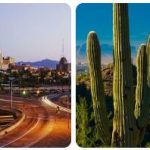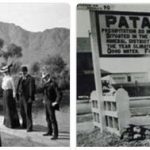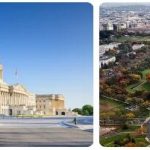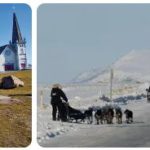Arizona is one of the states of the United States. The dry and sometimes very rugged landscape of Arizona is found in the southwestern US, bordering Utah, Collorado, Nevada, California, New Mexico, and the country of Mexico. The nicknames for Arizona are Grand Canyon State or Copper State. The Grand Canyon is immediately called the largest tourist attraction of Arizona. This huge gorge, together with the Painted Desert and Monument Valley, ensures that so many tourists include Arizona in their itinerary when traveling through the (south) west of the United States.
The size of the state of Arizona in combination with the many height differences ensures that there are a fairly large number of climate types, which do have a number of similarities. For example, a large part of Arizona consists of desert with the associated dry desert climates. The largest part has a warm desert climate, which locally in the east changes into a warm or cold steppe climate because there is more precipitation. For example, the city of Sierra Vista, located in the extreme southeast, registers 361 millimeters of precipitation on an annual basis, which means that, based on the drought index, there is a steppe climate.
Discover the Most Popular Vacation Destinations in Arizona
A similarity that applies to the entire desert area of Arizona is that large differences between the minimum and maximum temperatures can occur within 24 hours. Temperature differences of up to thirty degrees between the hottest and coolest moment of a day can occur almost everywhere. During the winters it is fairly warm during the day, the summer months are almost without exception very warm to sometimes extremely hot. In the period from June to September, the official temperature can rise to as much as 45 to 50 degrees Celsius. Sometimes the limit of fifty degrees is even crossed.
The northern part of Arizona is formed by a plateau with significantly more elevations than in the southern areas. Within this Colorado Plateau is also the Grand Canyon. Within the plateau there are a number of places where it is considerably colder in the winter months. You will also find areas where there is more precipitation than other places within Arizona. In fact, if you exclude Alaska, the city of Flagstaff would have the highest number of frost days in the United States.
Climate figures
The figures below are based on long-term average climate statistics. The temperatures are displayed in degrees Celsius (°C).
| maximum temperature | minimum temperature | hours of sunshine per day | days of rainfall per month | |
| January | 19℃ | 4℃ | 8 | 4 |
| February | 21℃ | 6℃ | 9 | 4 |
| March | 24℃ | 8℃ | 10 | 4 |
| April | 29℃ | 11℃ | 12 | 2 |
| May | 34℃ | 16℃ | 13 | 2 |
| June | 39℃ | 21℃ | 14 | 1 |
| July | 41℃ | 25℃ | 13 | 4 |
| August | 40℃ | 24℃ | 12 | 5 |
| September | 37℃ | 21℃ | 11 | 3 |
| October | 31℃ | 14℃ | 10 | 3 |
| November | 24℃ | 8℃ | 9 | 3 |
| December | 19℃ | 4℃ | 8 | 4 |
The climate of Bullhead City
Bullhead City is a medium-sized city in northwestern Arizona, on the state border with Nevada. Bullhead City is located in Mohave County on the Colorado River, which forms the border with Nevada here. On the other side of the Colorado is the town of Laughlin. The state line with California is several miles south of the city. The city originated at the end of the 19th century, but was then still called Hardyville. In the early 1900s, Hardyville became a ghost town. Bullhead City was built on the remains of Hardyville in the mid-20th century and named after the dam of the same name.
Bullhead City has a warm desert climate, with many warm days throughout the year. Especially during the summer period, long periods with extreme temperatures of more than 40 degrees Celsius can occur here. Precipitation is low throughout the year. During the winter months you have a small chance of night frost. Snow or wet snow rarely or never occurs here.
The climate of Flagstaff
Flagstaff is a large town in the central part of the state of Arizona, on the edge of the Colorado Plateau. Flagstaff is located in Coconino County, not far from the Grand Canyon, on the famous U.S. highway Route 66. The city overlooks Mount Elden, part of the San Francisco Peaks. The city was founded at the end of the 19th century and quickly grew to its present size with the arrival of the railway. This railway gave the city an important trading function. About 50 kilometers from the city is the Barringer Crater. This is the largest crater resulting from a meteorite impact currently found on Earth. The crater is 170 meters deep and 1,300 meters in diameter. The crater can be visited for a small fee.
Flagstaff has a cold steppe climate, with long periods of frost during the winter period. Most precipitation will come down as snow during the winter. Snow can remain on the highest peaks of the surrounding mountains for quite some time, but because the daytime temperatures here are too high during the summer months, there is no eternal snow. During the hottest summer days, the mercury can rise above 30 degrees Celsius.
The climate of the Grand Canyon
The Grand Canyon is a large canyon in the north of the state of Arizona and probably the most famous in the world. The Grand Canyon is part of the Grand Canyon National Park, a UNESCO World Heritage Site. In this park is the village of Grand Canyon Village, which is used by most tourists as a base to visit the Grand Canyon. The local airport is also close to the village. The Grand Canyon was created by the Colorado River running through it for thousands of years, slowly making its way through the bedrock. Originally the Pueblo peoples (Indians) lived in this area, who considered the Grand Canyon to be sacred.
The climate of the Grand Canyon varies considerably due to the many height differences. The higher parts of the Grand Canyon regularly see snowfall. The parts along the Colorado River never see snowfall. There are two small rainy periods here: the first in the month of March and the second during the high summer months of July and August. In the middle of summer it is mainly heavy showers that lead to rainfall. In winter precipitation falls regularly in the form of snow. More than 150 centimeters of snow can fall on the highest peaks of the Grand Canyon on an annual basis. It is wise to check the current weather for extremes before visiting the Grand Canyon. The cold record here is -28.9 degrees Celsius and the heat record at 40.6 degrees Celsius. The data below is from the city of Grand Canyon Village.
The climate of Kingman
Kingman is a medium-sized city in northwestern Arizona, not far from the Nevada and California state lines. Kingman is located in Mohave County, on the edge of the Mojave Desert. The city is located on the famous Route 66 highway. Outside the city are the Hualapai Mountains, containing the Hualapai Mountain County Park. This park can be visited for a small fee and you can also spend the night there.
Kingman has a cold desert climate, which is characterized by low precipitation and the cold winter period. The summer months are warm, with temperatures well above 30 degrees Celsius. The nights are generally a lot cooler. During the winter period there may be periods of frost and night frost, but these will usually not be of long duration.
The climate of Lake Havasu City
Lake Havasu City is a medium-sized city in northwestern Arizona where Lake Havasu forms the border with California. Lake Havasu City is located in Mohave County, on the Bridgewater Canal. Crossing this canal is the original London Bridge, bought by a local entrepreneur from the City of London. The bridge is one of the most popular tourist attractions in the state of Arizona. Lake Havasu City is a young city that only emerged in the 1960s. Lake Havasu was created by the construction of the Parkerdam.
Lake Havasu City has a warm desert climate, with many hot days during the summer period. The city and the surrounding area see very little rainfall on an annual basis. During the summer period the sun shines here on average 12 hours a day and the temperatures are just below 40 degrees Celsius. The nights can be very cold during the winter and frost should not be ruled out here.
The climate of Page
Page is a town in the north of the US state of Arizona. Lake Havasu City is a medium-sized city in northwestern Arizona where Lake Havasu forms the border with California. Lake Havasu City is located in Mohave County, on the Bridgewater Canal. Crossing this canal is the original London Bridge, bought by a local entrepreneur from the City of London. The bridge is one of the most popular tourist attractions in the state of Arizona. Lake Havasu City is a young city that only emerged in the 1960s. Lake Havasu was created by the construction of the Parkerdam.
Lake Havasu City has a warm desert climate, with many hot days during the summer period. The city and the surrounding area see very little rainfall on an annual basis. During the summer period the sun shines here on average 12 hours a day and the temperatures are just below 40 degrees Celsius. The nights can be very cold during the winter and frost should not be ruled out here.
The Climate of the Painted Desert
The name sometimes says a lot about the destination. In the case of the Painted Desert, at least it is. Instead of the landscape having a dominant color, the Painted Desert has many colors that are shown in layers on top of each other. Erosion has ensured that so-called badlands show all kinds of beautiful colors: from deep red to light gray and from sulfur green to lavender purple. Located in the north of the state of Arizona, the area covers an area of 378 square kilometers, located between the Grand Canyon and the Petrified Forest National Park. Much of the Painted Desert lies within the Four Corners Reservation of the Navajo (Dineh).
In the Painted Desert, the cold desert climate or the BWk climate prevails. This arid climate type is known for the low amounts of precipitation and the great contrasts in temperature. For example, in the summer in the Painted Desert it is sometimes blistering hot, while in the winter months you can drive through a wintry landscape with snow. The amounts of snow are often very limited, but it can be enough to give the already enchanting landscape a special touch.
The climate of Payson
Payson is a town centrally located in the US state of Arizona. In fact, it is so close to the geographic center of Arizona that Payson has been nicknamed “The Heart of Arizona”. What few know is that Payson has the longest history of rodeos. The first rodeo was held in 1884 and has been an annual event ever since. Payson ‘s rodeo “, something that people here are very proud of.
Partly due to its elevation of 1,524 meters above sea level, Payson’s climate differs from what is usual for Arizona. Payson does not have an arid climate, but a so-called warm Mediterranean climate, which is referred to as a Csa climate within the Köppen climate system. The changeable weather is remarkable. For example, in the winter you can have a snow storm one day, while two days later it can be so warm that the white layer disappears within a day or two.
The climate of the Petrified Forest National Park
The Petrified Forest National Park is a 88-acre national park in the US state of Arizona. It is best known for its petrified trees. The tree trunks you encounter in the desert landscape are mainly of the species Araucarioxylon arizonicum. The petrified trees were created because they were preserved by silicon, which is found in the volcanic ash that covered the tree trunks for a long time. Numerous fossils have been discovered within the area, including fish, proving that this was once a wetland area. The landscape of the Petrified Forest National Park shows several beautiful geological phenomena, such as the Tepees. These bullet-shaped mounds show near-perfect layers of rock of varying colors. These Tepees were created by erosion.
Within the Köppen climate system, the Petrified Forest National Park has a cold steppe climate (BSk climate). This semi-arid climate type is mainly based on the low amounts of precipitation that fall here. The average precipitation sum is 200 to 300 millimeters. In winter, precipitation can fall in the form of snow. Especially during the night it can be cool enough to get winter precipitation.
The climate of Phoenix
Phoenix is the capital of the US state of Arizona. The metropolis of more than four million inhabitants is located fairly centrally in Arizona. The city is almost flat, while there are reasonable differences in height immediately around the city. That’s because Phoenix is located in a valley, the Salt River Valley (also called “Valley of the Sun”).
Because Phoenix is located in the Sonoran Desert, the city has a warm desert climate, indicated within the Köppen climate system with the code BWh. Phoenix is characterized by extremely hot summers and warm winters. With a total number of hours of sunshine of almost 3900 hours per year, the sun shines more than 85% of the theoretical maximum possible time. This makes Phoenix one of the sunniest cities in the world. Within the United States, it is the city with the most number of days with a temperature of 100 degrees Fahrenheit (38 degrees Celsius). In total, this occurs no less than 110 days a year. In addition to being very hot, Phoenix is also a dry city. on an annual basis there is an average of about two hundred millimeters of rain. The months of May and June are the driest. It rarely rains during these months.
The climate of Seligman
Seligman is a village in the US state of Arizona. The original name of the village of roughly five hundred inhabitants was Prescott Junction. That name comes from the time when Seligman was mainly a railway intersection. Today, Seligman is best known for its location on the historic Route 66 autoroute. The Seligman Commercial Historic District was listed on the National Register of Historic Places in 2005. For tourists, this is one of the better places in Arizona to get acquainted with the historic highway. Several landmarks recall Seligman’s time as a major stopping point along Route 66, including motels, bars and a great gas station.
Seligman has a cold steppe climate. This BWk climate is a so-called semi-arid climate. The annual precipitation sum of 300 to 350 millimeters on average is too high to qualify for a desert climate. The landscape around Seligman is quite dry. It is mainly dry grasses and some shrubs that determine the image around Seligman. This is mainly due to the relatively low amounts of precipitation. The wettest months (July and August) are so warm that the rain that falls often evaporates before it can penetrate the ground. The average maximum temperatures are then around 32 to 36 degrees, with regular peaks towards 40 degrees. Winters in Seligman are quite mild. Daytime temperatures are around 12 degrees in the coldest months of December and January and light to moderate frost is normal at night.
The best time to visit Seligman is from mid-April to mid-June. It is then warm, dry and sunny. While tropical temperatures can certainly occur, the temperature is generally fine to explore Seligman’s photogenic main street on foot. In the summer it can be just a bit too hot for this during the day.
The climate of Sierra Vista
Sierra Vista is a medium-sized city in the extreme southeast of the state of Arizona, not far from the Mexican border. Sierra Vista is located in Cochise County on the San Pedro River and is surrounded by several mountains, the largest of which is the Huachuca Mountains; Miller Peak is the highest point in the region at 2,885 metres. Outside the city is Fort Huachuca, which has been in use as a military base since 1877. It is also one of the city’s largest employers.
Sierra Vista has a cold steppe climate, with the most precipitation during the summer months. The highest peaks of the surrounding mountains are covered with snow during the winter months. Temperatures are well above 30 degrees Celsius during the summer months. During those months, the sun shines here on average 12 hours a day. In the winter period frost and or night frost can occur.
The climate of Tucson
Tucson is a large city in the south-central part of the state of Arizona, not far from the border with Mexico. The city is located in Pima County and is surrounded by 5 small mountain ranges: the Santa Catalina Mountains, the Tortolita Mountains, the Santa Rita Mountains, the Rincon Mountains and the Tucson Mountains. The highest mountain in the Santa Catalina Mountains is Mount Lemmon, which is ideal for winter sports enthusiasts. This is the southernmost ski resort in the US. Tucson is located on the Santa Cruz River. One of the city’s largest employers is Davis-Monthan Air Force Base. At this army base is the boneyard, a scrap heap for discarded army planes and helicopters. There are hundreds of bombers, F16s and so on and so forth. Outside the city is the Arizona-Sonora Desert Museum.
Tucson has a warm desert climate, with little rainfall throughout the year. The summer months are dry, with temperatures well above 40 degrees Celsius on the hottest days of the year. On average, they are just above 35 degrees Celsius. During the winter period you have a small chance of night frost here. When there is frost, snow or sleet may fall here, but it will never remain for long.
The climate of Williams
Williams is a village that is located fairly centrally in the American state of Arizona. The village mainly has a tourist function. The atmosphere of Williams exhaling clearly has traces of America of the past, when Route 66 was still an important auto route through the US. Part of this historic route can still be ridden today and will take you – just like in the past – in Williams, where you can then join Interstate 40.
Williams is located in the cooler and somewhat wetter part of Arizona. There is no longer a desert climate here, but you are dealing with a Mediterranean climate, with winters being mild with cool nights and pleasantly warm in the summer months. It is striking that in the case of Williams, the two warmest months (July and August) are also the wettest months of the year. There is on average about 70 to 90 millimeters of rain per month. In the winter months, precipitation often falls in the form of snow. If you look at the long-term climate statistics, you can expect some snowfall in Williams on roughly 18 to 20 days per year.
The climate of Yuma
Yuma is a large city in the extreme southwest of the state of Arizona, near the state line with California. Yuma is located in Yuma County, near the border with Mexico. Not far from town is the Yuma Crossing, which used to connect Las Californias and New Spain across the Colorado River. Fort Yuma used to be at this crossing, after which the city is named. The Yuma Quartermaster Depot State Historic Park is now located here.
Yuma has a warm desert climate, with extremely little rainfall throughout the year. Temperatures are high all year round, peaking during the summer months. Then the mercury can rise considerably and temperatures of more than 50 degrees Celsius are certainly no exception. Light frost may occur during the winter months.








